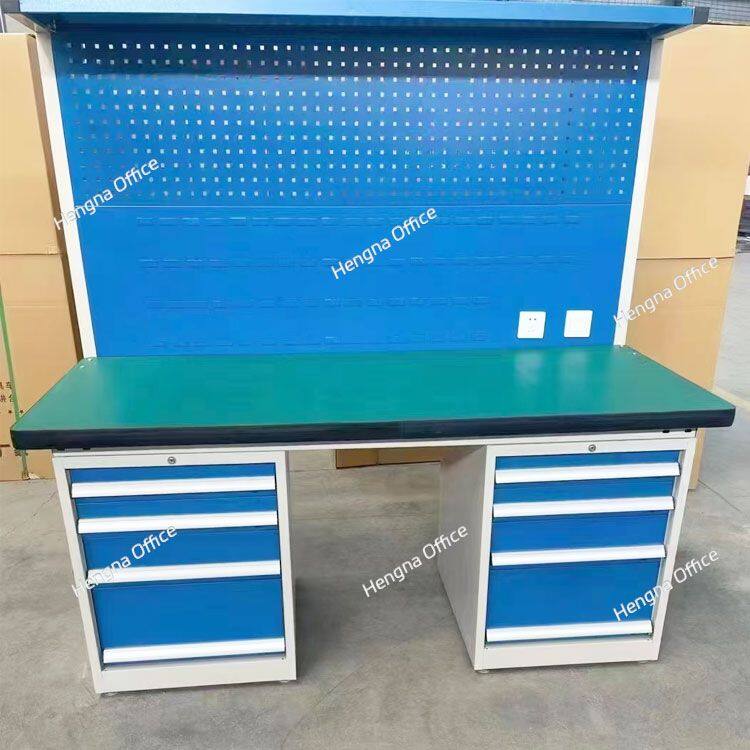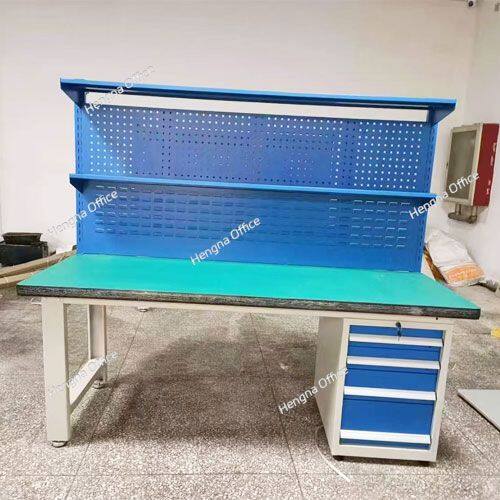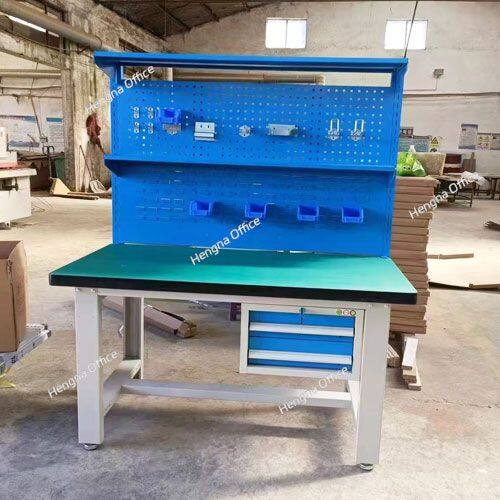-
 Sarah
Hi there! Welcome to my shop. Let me know if you have any questions.
Sarah
Hi there! Welcome to my shop. Let me know if you have any questions.
Your message has exceeded the limit.

Industrial Heavy Workbenches: Boosting Productivity in Manufacturing
2025-11-03 13:39:40
Manufacturing facilities and industrial plants require workbenches that can withstand constant heavy use while supporting efficient production processes. Industrial heavy workbenches serve as foundational equipment that directly impacts worker productivity, product quality, and operational efficiency. This comprehensive guide explores how industrial workbenches enhance manufacturing operations and the essential features to consider when selecting workbenches for industrial applications.
![sadwqw]](https://img11.fr-trading.com/0/1_34_119122_750_750.jpg?t=1762148329)
Understanding Industrial Manufacturing Requirements
Industrial manufacturing environments present unique challenges that demand specialized workbench solutions. The need to support heavy components, withstand constant use, and integrate with production processes requires workbenches designed specifically for industrial applications. Manufacturing operations often involve multiple shifts, various production processes, and strict quality requirements that influence workbench design and selection.
Professional manufacturing environments require workbenches that facilitate efficient workflow while maintaining organization and accessibility. The ability to integrate with production equipment, support quality control processes, and accommodate various manufacturing techniques directly impacts productivity and product quality. These specialized requirements distinguish industrial workbenches from lighter-duty alternatives.
Weight Capacity and Load Distribution
Manufacturing operations often involve heavy components, assemblies, and tooling that require substantial support capacity. Industrial heavy workbenches typically support 1000-4000 pounds distributed across the surface, with some specialized models exceeding 10,000 pounds capacity. This capacity must be maintained without deflection that could compromise precision work or product quality.
Load distribution considerations influence workbench design and placement. Heavy-duty leg construction, often 4x4 or larger steel tubing, provides the foundation for load capacity. Cross-bracing and reinforced frames prevent racking under uneven loads. Some industrial workbenches feature adjustable load distribution systems that accommodate various weight configurations and production requirements.
Durability and Construction Standards
Industrial workbenches must withstand constant use, impacts, and environmental challenges without failure. Quality construction typically features heavy-gauge steel frames, often 10-12 gauge thickness, providing exceptional strength and rigidity. Welded construction rather than bolted connections eliminates potential failure points under stress and extends service life.
Surface materials must resist impacts, chemical exposure, and constant use. Steel plate surfaces, typically 1/4 to 1/2 inch thick, provide durability and easy maintenance. Some industrial workbenches incorporate specialized surface treatments including powder coatings, chemical-resistant finishes, or replaceable wear plates that extend service life and reduce maintenance requirements.
Ergonomics and Worker Productivity
Worker ergonomics directly impact productivity, quality, and workplace safety in manufacturing environments. Industrial workbench height typically ranges from 36-42 inches, with customization based on specific tasks and worker heights. Some models offer height adjustability to accommodate different workers and various manufacturing processes.

Anti-fatigue considerations include built-in matting, adjustable work surfaces, and tool positioning that reduces physical strain. Proper lighting integration prevents eye strain during detailed assembly or inspection work. Consideration of workflow patterns influences workbench design, optimizing placement of tools, materials, and work areas for efficient manufacturing processes.
Integration with Manufacturing Equipment
Modern manufacturing often requires workbenches that integrate seamlessly with production equipment and technology. Industrial workbenches may incorporate mounting points for machinery, tool holders, or specialized fixtures. Built-in power distribution systems provide electrical access for tools, testing equipment, or assembly devices.
Some industrial workbenches feature data integration capabilities, including connections for manufacturing execution systems, quality control equipment, or inventory management systems. Cable management systems keep electrical and data cables organized and prevent trip hazards. This integration capability enhances efficiency and supports advanced manufacturing processes.
Quality Control and Inspection Features
Manufacturing quality control often requires specialized workbench features that support inspection and testing processes. Integrated measuring systems, precision surfaces, and inspection lighting facilitate quality control operations. Some industrial workbenches feature built-in testing stations or inspection areas that streamline quality control processes.
Surface flatness and stability become crucial for precision assembly or inspection work. Some industrial workbenches feature vibration-dampening designs that maintain stability during precision operations. Built-in documentation areas or computer mounting supports quality control record-keeping and process monitoring. These quality control features enhance product consistency and manufacturing efficiency.
Modular Design and Flexibility
Manufacturing operations evolve over time, requiring workbenches that can adapt to changing production needs. Modular industrial workbenches allow for reconfiguration, expansion, or modification as production processes change. The ability to add components, adjust heights, or connect multiple units creates versatile workspaces that adapt to evolving requirements.
Some manufacturers utilize configurable workbench systems that can be quickly reconfigured for different products or production runs. Mobile options with heavy-duty casters provide flexibility for layout changes or specific manufacturing projects. This adaptability ensures long-term utility and value for manufacturing operations facing changing market demands or production requirements.
Safety Features and Compliance
Manufacturing safety requires comprehensive protection strategies, and workbenches play crucial roles in workplace safety programs. Rounded corners and edges reduce injury risk during busy production periods. Built-in safety features including non-slip surfaces, secure drawer locking mechanisms, and emergency stop integration prevent accidents and injuries.

Compliance with OSHA standards and local building codes ensures safe operation in manufacturing facilities. Proper anchoring prevents tipping, especially important for tall or heavily loaded workbenches. Regular inspection and maintenance of all components ensures continued safe operation throughout the workbench service life. Some industrial workbenches incorporate built-in safety guarding or ergonomic features that reduce workplace injuries.
Material Handling and Workflow Integration
Efficient material handling directly impacts manufacturing productivity, and workbenches play important roles in material flow. Industrial workbenches may incorporate built-in conveyor systems, roller tables, or transfer stations that streamline material movement. Some models feature integrated packaging stations or quality hold areas that facilitate smooth production flow.
Workflow considerations influence workbench design and placement. The ability to support multiple workers or collaborative processes enhances production flexibility. Some industrial workbenches feature multi-level designs that maximize space utilization while maintaining efficient material flow. These material handling features directly impact manufacturing efficiency and throughput.
Maintenance and Service Life
Industrial workbenches represent significant investments that must provide reliable service for many years. Quality construction materials and finishes resist wear, corrosion, and damage from constant use. Modular designs allow for component replacement rather than complete workbench replacement when damage occurs.
Regular maintenance procedures ensure continued performance and extend service life. Surface inspection and replacement prevents wear that could affect product quality. Hardware inspection and tightening prevents loose components that could compromise stability. Cleaning removes debris and contaminants that could affect manufacturing processes. These maintenance practices protect the investment and ensure reliable performance.
ROI and Productivity Impact
Industrial workbench investments directly impact manufacturing productivity and profitability. Quality workbenches enhance worker efficiency, reduce production errors, and improve product quality. The ability to support advanced manufacturing processes and technology integration provides competitive advantages and supports business growth.
ROI calculations should consider both direct financial benefits and indirect advantages such as improved worker satisfaction and reduced turnover. Enhanced safety features reduce workplace injuries and associated costs. Improved organization and workflow efficiency reduce production time and labor costs. These factors combine to deliver compelling returns on industrial workbench investments.

Tags: Industrial Heavy Workbenches, Boosting Productivity in Manufacturing, Heavy Workbenches

